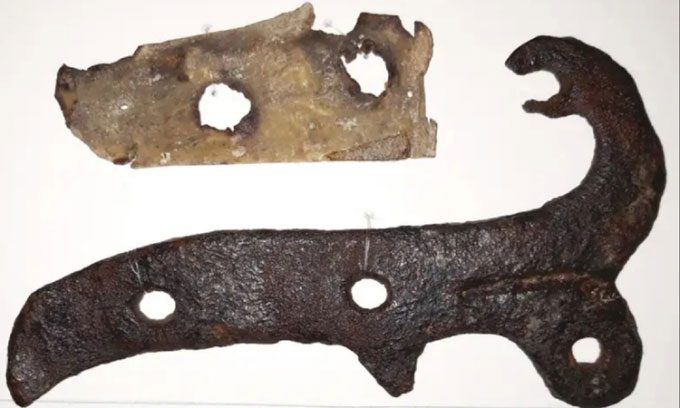The pieces of skin nailed to the doors of some medieval churches are not actually from a punished Danish raider, as the legend suggests.
In the late 19th century, during the restoration of St. Botolph’s Church in Hadstock, near Cambridge, a large piece of skin was discovered beneath the metal strips of a door frame. Legend has it that this piece of skin belonged to a Danish raider (Viking) who attempted to plunder the church in the 11th century. He was subsequently flayed and nailed to the door as a warning.
St. Botolph’s is not the only church with “human skin” at its front door. In England, at least three other medieval structures feature similar pieces of skin, including St. Michael’s Church, All Angels Church, and Westminster Abbey.

A piece of skin and a hinge from St. Botolph’s Church in Hadstock, England. (Photo: Saffron Walden Museum).
Previously, scientists sought to determine the veracity of these legends and analyzed several samples. However, the actual nature of the skin remains controversial. In the 1970s, Ron Reed, a leather expert at the University of Leeds, analyzed the skin sample from St. Botolph’s and concluded it was human skin, possibly from a person with light or gray hair. However, in the 2001 BBC program “Blood of the Vikings,” DNA analysis indicated that the sample originated from the Bovidae family, though this could not be confirmed with complete certainty.
At the 2022 UK Archaeological Science Conference (UKAS), expert Ruairidh Macleod and colleagues conducted a more detailed analysis of the skin samples from all four locations using a non-destructive technique called ZooMS. This technique revealed the collagen peptide sequences within the samples, allowing scientists to identify the species to which the sample belonged. In this case, they used a rubber eraser to interact with the surface of the skin, then extracted the peptides that adhered to the eraser fragments.
As a result, none of the samples were human skin. Two samples from St. Botolph’s Church and Westminster Abbey originated from the Bovidae family, while the samples from St. Michael’s Church and All Angels Church belonged to horses or donkeys. They could not determine more specifically, as horses and donkeys have very similar collagen traces.
“It is interesting that the churches we analyzed have very similar legends, claiming that these pieces of skin originated from a Danish raider (Viking). This was first documented by Samuel Pepys in his diary in 1661. Therefore, the legend that these are flayed pieces of Danish people has existed for a long time,” Macleod stated.
“Since none of the samples were actually human skin, this story likely originated as a local legend from one of the churches, which then quickly spread to other places with similar traces of dried skin nailed to doors,” he noted.
Experts suggest that the nailing of animal skins to church doors may have been related to aesthetics. “However, the allure of the legend of human skin, as well as its deterrent effect on church vandals, may explain the persistence of the legend,” Macleod added.





















































